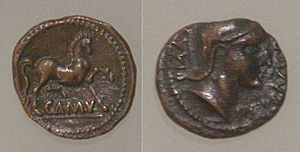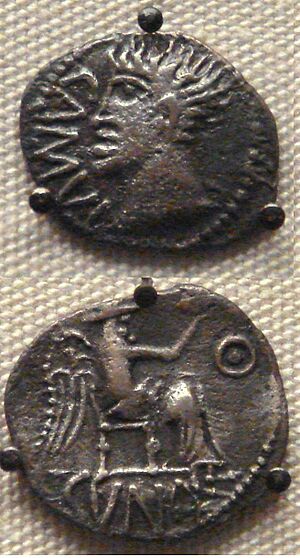Cunobeline facts for kids
Cunobeline was a powerful king in ancient Britain. He ruled from about AD 9 to AD 40. Roman writers mentioned him, and many of his coins have been found. He controlled a large part of southeast Britain. This included the lands of the Catuvellauni and Trinovantes tribes. The Roman emperor Augustus likely saw him as a friendly king. Cunobeline is also known as Cymbeline in a play by William Shakespeare.
Contents
What's in a Name?
Cunobeline's name comes from two old British words. *cuno- means "dog" and *belino- means "strong". So, his name means "Strong as a Dog" or "Strong Dog".
Cunobeline's Story
Becoming King
Cunobeline became king around AD 9. This was after his father, Tasciovanus, died. He made coins in two main cities: Camulodunum (now Colchester) and Verlamion (now St Albans). His coins from Verlamion show he was Tasciovanus's son.
Some of his first coins from Camulodunum had a Roman-style wreath. This might mean he won a military victory. He may have taken control of the Trinovantes tribe's land. The Romans had protected this tribe, but they were busy with problems elsewhere.
Friends with Rome
Cunobeline had good relations with the Roman Empire. He used the Latin word Rex (meaning 'king') on his coins. Trade with Europe grew a lot during his rule. Archeologists have found many luxury goods from Rome. These include wine, olive oil, and fancy dishes. These goods likely came through the port of Camulodunum. Cunobeline probably sent messengers to the Roman emperor Augustus.
His Family
Cunobeline had three sons: Adminius, Togodumnus, and Caratacus. He also had a brother named Epaticcus. Epaticcus expanded their kingdom into the land of the Atrebates tribe. He even took their main city, Calleva, around AD 25. When Epaticcus died around AD 35, Caratacus took over.
Adminius, one of Cunobeline's sons, controlled the area of Kent. Around AD 40, his father, Cunobeline, sent him away from Britain. Adminius went to the Roman emperor Caligula for help. Caligula pretended this meant all of Britain had given up to him. He even planned an invasion, but it was a joke. He told his soldiers to attack the waves and collect seashells as prizes!
The End of His Reign
Cunobeline died around AD 40, or certainly by AD 43. A large burial mound near Colchester, called the Lexden Tumulus, might be his tomb.
After Cunobeline died, his son Caratacus continued to conquer the Atrebates tribe. Their king, Verica, fled to Rome. This gave the new Roman emperor, Claudius, a reason to invade Britain in AD 43. Caratacus and Togodumnus led the fight against the Romans. Some tribes, like the Dobunni, who used to pay tribute to Cunobeline's kingdom, switched sides and helped the Romans. This shows how far Cunobeline's power reached.
Cunobeline in Stories

Cunobeline's name lived on in British legends. In early stories, he appeared as Bellinus or Beli Mawr (Beli the Great). Over time, his story changed and mixed with other tales.
In the 12th century, a writer named Geoffrey of Monmouth wrote about Cunobeline. He called him Kymbelinus. In Geoffrey's story, Kymbelinus was a strong warrior who grew up in the Roman court. He was very friendly with Rome. His country used Roman weapons, and he paid tribute to Rome out of respect. He had two sons, Guiderius and Arvirargus.
Geoffrey's story was later used by William Shakespeare for his play, Cymbeline. However, Shakespeare's play is very different from the real history of Cunobeline. In the play, Cymbeline is reunited with his sons, and peace is made with Rome.
See also
 In Spanish: Cunobelino para niños
In Spanish: Cunobelino para niños


